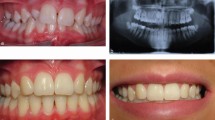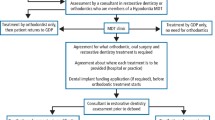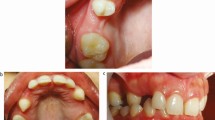Abstract
This article aims to give an overview of the part orthodontics plays in the management of hypodontia cases. Severity of hypodontia varies and some cases can be managed by orthodontics alone. The more complex cases benefit from multidisciplinary care with a combination of orthodontics and restorative treatment. This article sub-divides orthodontic involvement in hypodontia cases into three distinct phases, while providing clinical examples to highlight the management of a variety of cases ranging from simple to complex.
Key points
-
Provides an overview of orthodontic planning and management in hypodontia cases.
-
Discusses the importance of multi-disciplinary management of hypodontia cases.
-
Outlines which clinical features associated with hypodontia are challenging to manage.
This is a preview of subscription content, access via your institution
Access options
Subscribe to this journal
Receive 24 print issues and online access
$259.00 per year
only $10.79 per issue
Buy this article
- Purchase on Springer Link
- Instant access to full article PDF
Prices may be subject to local taxes which are calculated during checkout

















Similar content being viewed by others
References
AlShahrani I, Togoo R A, AlQarni M A. A Review of Hypodontia: Classification, Prevalence, Aetiology, Associated Anomalies, Clinical Implications and Treatment Options. World J Dent 2013; 4: 117-125.
Peck L, Peck S, Attia Y. Maxillary canine-first premolar transposition, associated dental anomalies and genetic basis. Angle Orthod 1993; 63: 99-109.
Peck S, Peck L. Classification of maxillary tooth transpositions. Am J Orthod Dentofacial Orthop 1995; 107: 505-517.
Peck S, Peck L, Kataja M. Concomitant occurrence of canine malposition and tooth agenesis: evidence of orofacial genetic fields. Am J Orthod Dentofacial Orthop 2002; 122: 657-660.
Ruiz-Mealin E V, Parekh S, Jones S P, Moles D R, Gill D S. Radiographic study of delayed tooth development in patients with dental agenesis. Am J Orthod Dentofacial Orthop 2012; 141: 307-314.
Polder B J, Van't Hof M A, Van der Linden F P, Kuijpers-Jagtman A M. A meta-analysis of the prevalence of dental agenesis of permanent teeth. Community Dent Oral Epidemiol 2004; 32: 217-226.
Naoum S, Allan Z, Yeap C K et al. Trends in orthodontic management strategies for patients with congenitally missing lateral incisors and premolars. Angle Orthod 2021; 91: 477-483.
Gill D S, Barker C S. The multidisciplinary management of hypodontia: a team approach. Br Dent J 2015; 218: 143-149.
Jepson N J, Nohl F S, Carter N E et al. The interdisciplinary management of hypodontia: restorative dentistry. Br Dent J 2003; 194: 299-304.
Becker A, Chaushu S. Etiology of maxillary canine impaction: A review. Am J Orthod Dentofacial Orthop 2015; 148: 557-567.
Bass T B. Observations on the misplaced upper canine tooth. Dent Pract Dent Rec 1967; 18: 25-33.
Øgaard B, Krogstad O. Craniofacial structure and soft tissue profile in patients with severe hypodontia. Am J Orthod Dentofacial Orthop 1995; 108: 472-477.
Hobkirk J A, Goodman J R, Jones S P. Presenting complaints and findings in a group of patients attending a hypodontia clinic. Br Dent J 1994; 177: 337-339.
Gungor A Y, Turkkahraman H. Tooth sizes in nonsyndromic hypodontia patients. Angle Orthod 2012; 83: 16-21.
Baccetti T. Tooth rotation associated with aplasia of nonadjacent teeth. Angle Orthod 1998; 68: 471-474.
Bertl K, Bertl M H, Heimel P et al. Alveolar bone resorption after primary tooth loss has a negative impact on straightforward implant installation in patients with agenesis of the lower second premolar. Clin Oral Implants Res 2018; 29: 155-163.
Bjerklin K, Bennett J. The long-term survival of lower second primary molars in subjects with agenesis of the premolars. Eur J Orthod 2000; 22: 245-255.
Levander E, Malmgren O, Stenback K. Apical root resorption during orthodontic treatment of patients with multiple aplasia: a study of maxillary incisors. Eur J Orthod 1998; 20: 427-434.
Lee R T. The lower incisor bonded retainer in clinical practice: a three year study. Br J Orthod 1981; 8: 15-18.
Zachrisson B U. The bonded lingual retainer and multiple spacing of anterior teeth. Swed Dent J Suppl 1982; 15: 247-255.
Rowland H, Hichens L, Williams A et al. The effectiveness of Hawley and vacuum-formed retainers: a single-centre randomized controlled trial. Am J Orthod Dentofacial Orthop 2007; 132: 730-737.
Needham R, Waring D T, Smith J, Malik O H. The invisible Hawley retainer. J Orthod 2015; 42: 333-341.
Author information
Authors and Affiliations
Contributions
Laura Ewbank, Susi Caldwell and Richard Needham were all involved in planning, drafting, writing and editing the manuscript.
Corresponding author
Ethics declarations
The authors declare no conflicts of interest.
Rights and permissions
About this article
Cite this article
Ewbank, L., Caldwell, S. & Needham, R. Orthodontic input in the management of hypodontia cases. Br Dent J 235, 463–469 (2023). https://doi.org/10.1038/s41415-023-6317-4
Received:
Revised:
Accepted:
Published:
Issue Date:
DOI: https://doi.org/10.1038/s41415-023-6317-4



